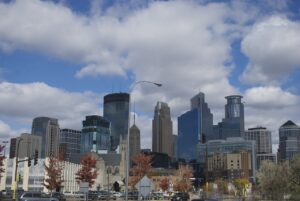BY JACKSON O’BRIEN
This March, the citizens of Minneapolis were hit with a one-two punch of bad news. First, the city announced that, for the first time in a decade, property values have fallen. The majority of this fall came from declining values in downtown office buildings, as it’s become increasingly clear that for many former downtown workers, working from home is a preferable new normal. The second bit of bad news came after the city passed its measure guaranteeing a minimum rate of pay for rideshare drivers, resulting in an announcement that Uber and Lyft will be departing the city on May 1. While this impacts Minneapolitans in a large number of ways, one of the biggest ones is that rideshares have become the default means of getting a safe ride to and from the bar, and critics both of the City Council passing the ordinance and of the rideshare companies that refuse to abide by the ruling is a fear of more impaired drivers on the road.
 To both of these pieces of bad news, I have a remedy. If you’re going to go out for drinks, take the bus and do it downtown.
To both of these pieces of bad news, I have a remedy. If you’re going to go out for drinks, take the bus and do it downtown.
Decades of transit planning based around office commuting have made it so that downtown Minneapolis is practically the default destination for dozens of transit lines. Few people live more than a five to ten-minute walk from a bus line that runs frequently and runs through downtown, with the Southside being served by lines number 4, 5, 6, 7, 9, 11, 14, 17, 18, and 22, along with the BRT D line and the Blue Line train. In addition, smartphone technology has made planning a bus trip a breeze, with apps like Google Maps and Transit being able to provide both the most convenient lines to take and providing departure and arrival times that are updated in real time as the lines operate. Many times I’ve scheduled a ride with a rideshare app where it’s given me options to discount my trip if I’m willing to wait a few minutes for a more conveniently located driver. If one is willing to wait an extra 15-20 minutes so that a rideshare costs $10 rather than $15, why not consider that same 15-20 minutes in walking time as something that will discount the fare from $15 to $2?
With their desperate attempts to get office workers to voluntarily come back downtown, it’s become obvious that the Downtown Council and Mayor Frey’s only plan for revitalizing downtown is to “make it 2019 again by the power of magic or science.” I worked downtown in 2019 and loved it. I loved wandering the skyways to find interesting hole-in-the-wall places for lunch. I loved walking to Target or Trader Joe’s to run some errands before I caught the bus back home. I loved how vibrant and bustling it felt. What I hated was that outside of the Monday to Friday, 9 to 5 workweek, this vibrant and bustling place became a ghost town. If we revelers make it a point to meet our friends for a cocktail or go on a date night in the heart of the city, we can make downtown a destination for not just workers but for leisure. Armchair urban planners have suggested that unused office spaces be converted into affordable housing, but lacking substantial changes to building structures and housing codes, turning these offices into apartments will result in apartments that are unaffordable, terrible to live in, or both. What is substantially more feasible is turning these offices into gathering places, be they shops, cafes, venues or taverns. That doesn’t start happening until the gathering places that do exist are popular enough that entrepreneurs want a piece of a bustling downtown pie.
The idea that a leisure-focused downtown is a healthy one is backed by data. According to a study by the City Center District Foundation of Philadelphia, the downtown that has retained the most workers and residents, and attracted the most visitors since 2020, is Nashville, Tennessee, a downtown region that is indisputably dominated by leisure spots. In addition, cities with leisure-focused downtowns like Nashville, Austin, and San Antonio saw property crimes decrease in the last four years and saw increases in investment by the private sector in the same stretch of time. What Minneapolis has that Nashville doesn’t is a transit system that efficiently, safely, and cheaply gets its partyers from their homes to the party and back again (and pays their operators a non-exploitative wage to do it).
Where decreasing property values and departing rideshare companies signal a downward spiral of declining tax bases and more unsafe roads, a leisure and transit-focused downtown can start a virtuous cycle where downtown becomes both increasingly valuable and where transit service improves with more ridership, decreasing our reliance on private cars and increasing road safety. City government and downtown business owners can bring money back to downtown by offering Minneapolitans a good time rather than berating them for being “losers” with a “dirty cat blanket.” What I propose is the notion that downtown isn’t for offices, but that downtown is for people.
























